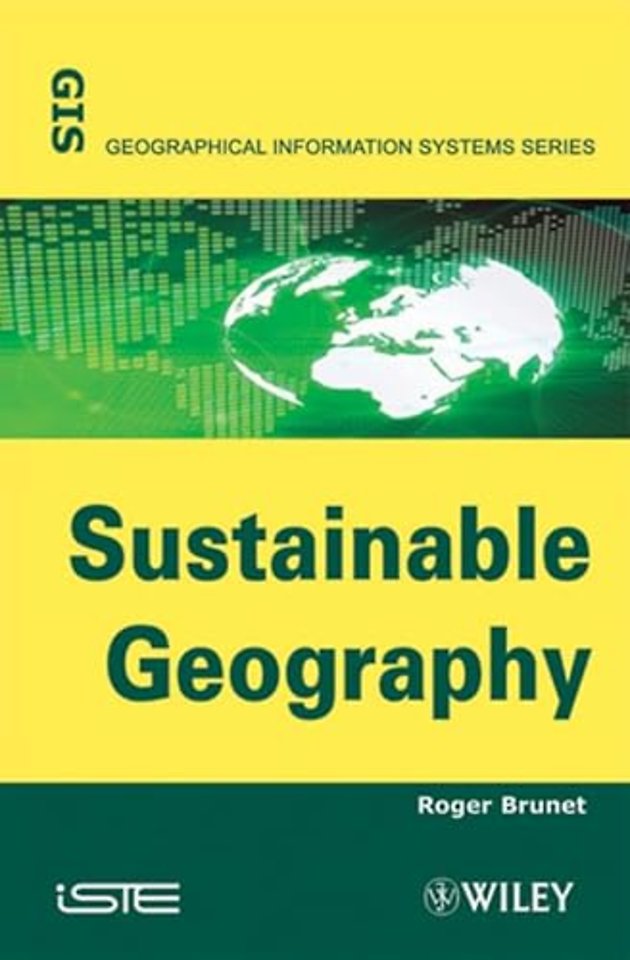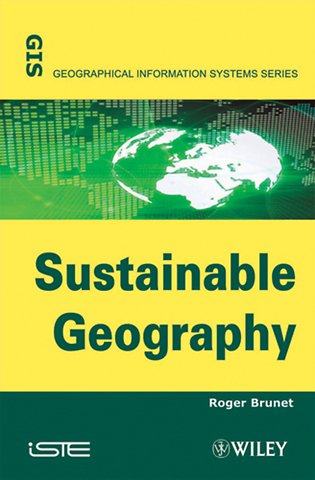Sustainable Geography
Gebonden Engels 2010 9781848211926Samenvatting
Sustainable Geography recalls the system and laws of geographical space production, tackles the hardcore of geography and presents models and organizations through a regional analysis and the dynamics of territorial structures and methods.
The book also describes the general idea of discontinuities, trenches, the anti–dialectical and redivision–uniformity in the globalization and addresses the Transnational Urban Systems and Urban Network in Europe.
Specificaties
Lezersrecensies
Inhoudsopgave
<p>Author Biography xix</p>
<p>PART 1. GEOGRAPHICAL SPACE PRODUCTION: SYSTEMS AND LAWS 1</p>
<p>Part 1. Introduction 3</p>
<p>Chapter 1. Geography: the Hard Core of a Social Science 5</p>
<p>1.1. The geographical question 5</p>
<p>1.2. Geographical space is produced 6</p>
<p>1.3. The reasons for the production of space 8</p>
<p>1.4. The organization of space 10</p>
<p>1.5. The logical field and the idea of a system in the production of space 13</p>
<p>1.6. The environment and the memories of the system 14</p>
<p>1.7. Geographical figures 16</p>
<p>1.8. Scientific practice 18</p>
<p>1.9. Conclusion 20</p>
<p>Chapter 2. The Geon and Energy of the System 23</p>
<p>2.1. Populations and working forces 26</p>
<p>2.2. Resources to actualize 28</p>
<p>2.3. Information as a source of negentropy 30</p>
<p>2.4. Production means and organization of space 33</p>
<p>2.5. The place of the capital and its distribution 35</p>
<p>2.6. The cybernetics of the system 38</p>
<p>2.7. Back to A 40</p>
<p>Chapter 3. Geographical Fields as the Environment of Places 43</p>
<p>3.1. Cardinal fields 44</p>
<p>3.2. Planetary fields 45</p>
<p>3.3. Cultural fields 46</p>
<p>3.4. The effects of exposure and attraction 47</p>
<p>3.5. Fields and geographical distributions 49</p>
<p>Chapter 4. Laws of Geographical Space Production 51</p>
<p>4.1. Geographic logic and the law of profit 52</p>
<p>4.2. Propositions of laws 53</p>
<p>4.3. Environment in systems 57</p>
<p>Chapter 5. Sense of Distance 59</p>
<p>5.1. Revelation of the distance 59</p>
<p>5.2. Distance measure 61</p>
<p>5.3. Ruptures of the distance 63</p>
<p>5.4. The represented distance: isolation and entrenchment 65</p>
<p>5.5. The distance and difference 67</p>
<p>5.6. End of distance? 70</p>
<p>PART 2. BROKEN SPACE 73</p>
<p>Part 2. Introduction 75</p>
<p>Chapter 6. Discontinuities and Thresholds 77</p>
<p>6.1. Discontinuity theory (1965) 77</p>
<p>6.2. Discontinuities and catastrophism 79</p>
<p>6.3. The region and discontinuity 84</p>
<p>6.4. Back to the discontinuity (1997) 86</p>
<p>6.5. Three examples of discontinuities in the geomorphological processes 89</p>
<p>Chapter 7. Territory Retrenchments 93</p>
<p>7.1. The pure and the wall 94</p>
<p>7.2. Retrenchments at the center 96</p>
<p>7.3. Separated peripheries 99</p>
<p>7.4. Folds and double folds 102</p>
<p>7.5. From retrenchment to res publica 104</p>
<p>Chapter 8. Antiworld and Alienation 107</p>
<p>8.1. Alienation 107</p>
<p>8.2. Antiworld 108</p>
<p>Chapter 9. Free Zones in the International Division of Labor 117</p>
<p>9.1. The territories of the antiworld 117</p>
<p>9.2. The complexity of the concept of international division of labor 119</p>
<p>9.3. The free zones: simplicity of speech, complexity of the roles 119</p>
<p>9.4. The golden belt 121</p>
<p>9.5. Territories without frankness, buccaneering territories 122</p>
<p>Chapter 10. Geography of the Gulag Archipelago 125</p>
<p>10.1. The sources of this survey 126</p>
<p>10.2. Geographical history 127</p>
<p>10.3. The organization of the archipelago 133</p>
<p>10.4. The modes of production 142</p>
<p>10.5. Conclusion 152</p>
<p>10.6. Appendix 153</p>
<p>Chapter 11. Geography of Migrations or the Antiworld in Spate 155</p>
<p>11.1. Waves and currents of emigration 156</p>
<p>11.2. Wanderings of insecurity, fracture of Mediterraneans 158</p>
<p>11.3. Migrations systems: nomadism or wandering 160</p>
<p>11.4. Conclusion 161</p>
<p>PART 3. MODELS AND CHOREMATICS 163</p>
<p>Part 3. Introduction 165</p>
<p>Chapter 12. Building Models for Spatial Analysis 167</p>
<p>12.1. From spatial organization to models 168</p>
<p>12.2. Choremes 172</p>
<p>12.3. The syntax of choremes or the linguistics of geography 183</p>
<p>Chapter 13. Model Maps and Choremes 191</p>
<p>13.1. Models and choremes 191</p>
<p>13.2. The rules of art 192</p>
<p>13.3. The procedure 194</p>
<p>13.4. In Poland, i.e. nowhere (A. Jarry) 195</p>
<p>13.5. The language of maps 198</p>
<p>13.6. Bibliography and References 199</p>
<p>Chapter 14. Models in Geography?A Sense to Research 201</p>
<p>14.1. What is a model? 202</p>
<p>14.2. Refutations 205</p>
<p>14.3. From theoretical practice to necessary hypotheses 208</p>
<p>14.4. Requirements of modeling 210</p>
<p>14.5. Conclusion 214</p>
<p>Chapter 15. Mediterranean Models 217</p>
<p>15.1. The lake 218</p>
<p>15.2. The focus 218</p>
<p>15.3. The straight 219</p>
<p>15.4. The isthmus 220</p>
<p>15.5. The crescents 221</p>
<p>15.6. The barrier 221</p>
<p>15.7. The chott 221</p>
<p>Chapter 16. The Aquitaine Region as a Corner 223</p>
<p>16.1. The southwest corner of France 223</p>
<p>16.2. Openings to seize 226</p>
<p>16.3. Dissymmetries of nature 229</p>
<p>16.4. Two urban systems 231</p>
<p>16.5. Regions and resources 234</p>
<p>Chapter 17. Structural Dynamic of the City of Tours (France) 239</p>
<p>17.1. Administrative center of a province on a Paris radius 241</p>
<p>17.2. The Val effect 243</p>
<p>17.3. The metropolization and the network star 244</p>
<p>17.4. Tours: social inequalities 248</p>
<p>Chapter 18. Analysis and Representation of Spatial Organizations: A Few Models 253</p>
<p>18.1. Openings 253</p>
<p>18.2. Color images 263</p>
<p>18.3. Other illustrations 263</p>
<p>PART 4. SCALES OF GLOBALIZATION AND MOVING EUROPE 267</p>
<p>Part 4. Introduction 269</p>
<p>Chapter 19. Ways, Forms, and Figures of Globalization 271</p>
<p>19.1. Economic globalization 272</p>
<p>19.2. The global village 273</p>
<p>19.3. Global ecology 275</p>
<p>19.4. How globalization changes the world 277</p>
<p>19.5. Re–differentiations and polycentrism 280</p>
<p>19.6. Contradictions and permanencies 282</p>
<p>19.7. Representations 283</p>
<p>Chapter 20. Aspects of Globalization: the Diamond Revolution 287</p>
<p>20.1. The De Beers empire: a heritage of British imperialism 287</p>
<p>20.2. After globalization by monopoly, polycentric globalization 291</p>
<p>20.3. Rupture and uncertainties at the turn of the millennium 296</p>
<p>Chapter 21. European Fields and Mainlines 299</p>
<p>21.1. The peninsula of the old continent 299</p>
<p>21.2. The European backbone 301</p>
<p>21.3. The Ring 302</p>
<p>21.4. The European trellis 304</p>
<p>21.5. Centralities, barriers and new found solidarities 306</p>
<p>21.6. Conclusions 308</p>
<p>21.7. Appendix: Blue Banana 308</p>
<p>Chapter 22. Transnational Urban Systems in Europe: Towards a New Modernity 311</p>
<p>22.1. Europe as a milieu 313</p>
<p>22.2. Can transnational city systems help Europe? 315</p>
<p>22.3. Conclusions 322</p>
<p>Chapter 23. Russia in Revolutions 325</p>
<p>PART 5. GEOGRAPHY INTO THE CITY PROSPECTS 333</p>
<p>Part. 5. Introduction 335</p>
<p>Chapter 24. Regaining Reason 337</p>
<p>24.1. El sueño de la razón 337</p>
<p>24.2. Unsustainable city 338</p>
<p>24.3. Territories in competition 339</p>
<p>24.4. Si les signes vous faschent 340</p>
<p>24.5. The marshland of Entelechies 341</p>
<p>24.6. Serio ludere 342</p>
<p>Chapter 25. What is Geography? 343</p>
<p>25.1. The field of geography 343</p>
<p>25.2. Geography as a science 345</p>
<p>25.3. Geographies 347</p>
<p>25.4. Geography as an established fact 351</p>
<p>25.5. Applied geography 353</p>
<p>Chapter 26. Geography in the Public Place 355</p>
<p>26.1. As an increased desire for geography 355</p>
<p>26.2. Five equations for fractions of society 356</p>
<p>26.3. Geography as Janus: two sides of the profession 358</p>
<p>26.4. Currents and patterns, or navigating without sinking 360</p>
<p>26.5. For socially useful works 362</p>
<p>26.6. Conclusion 364</p>
<p>Chapter 27. Geography and Human Rights 365</p>
<p>27.1. The difference 365</p>
<p>27.2. Resorting to nature 367</p>
<p>27.3. The revealing space 368</p>
<p>27.4. Conclusion 370</p>
<p>Chapter 28. Dimensions of Sustainable Development 371</p>
<p>28.1. The scale of sustainable development is global 372</p>
<p>28.2. Worldwide contradictions of sustainable development 374</p>
<p>28.3. Local scale: untenable sustainable city 378</p>
<p>28.4. The intermediate scales 380</p>
<p>28.5. Conclusions 382</p>
<p>Conclusion. Along the Way 383</p>
<p>Index 385</p>
Rubrieken
- advisering
- algemeen management
- coaching en trainen
- communicatie en media
- economie
- financieel management
- inkoop en logistiek
- internet en social media
- it-management / ict
- juridisch
- leiderschap
- marketing
- mens en maatschappij
- non-profit
- ondernemen
- organisatiekunde
- personal finance
- personeelsmanagement
- persoonlijke effectiviteit
- projectmanagement
- psychologie
- reclame en verkoop
- strategisch management
- verandermanagement
- werk en loopbaan

